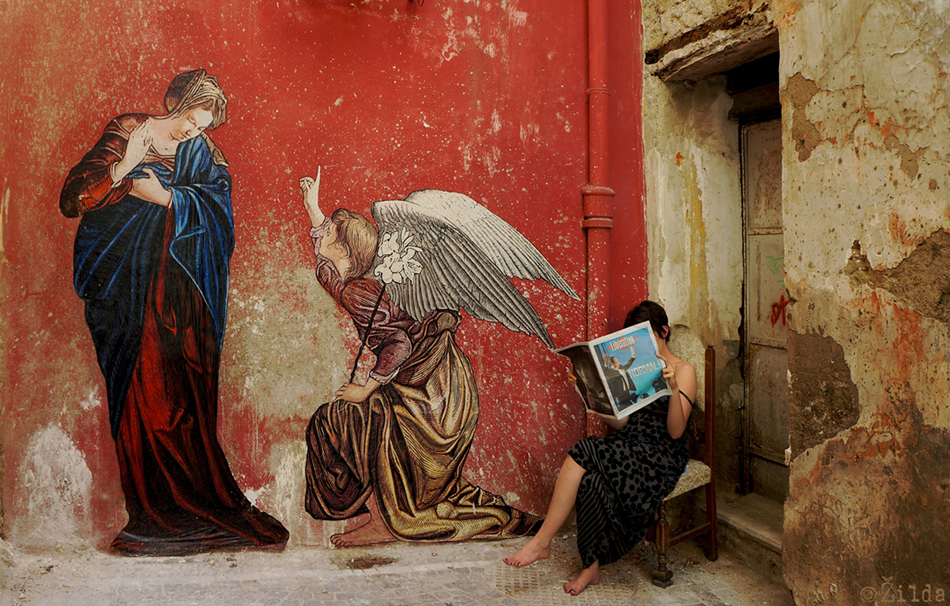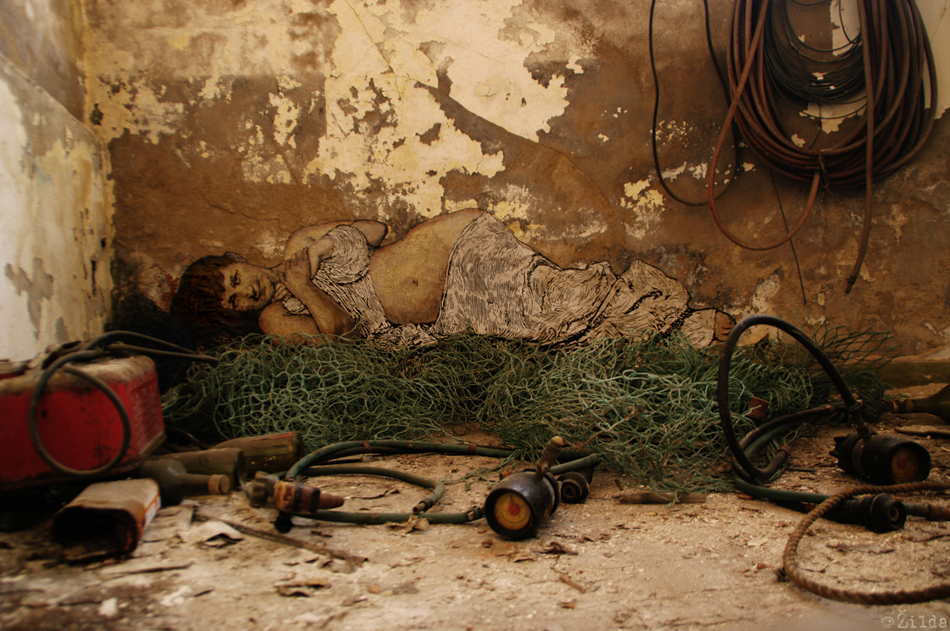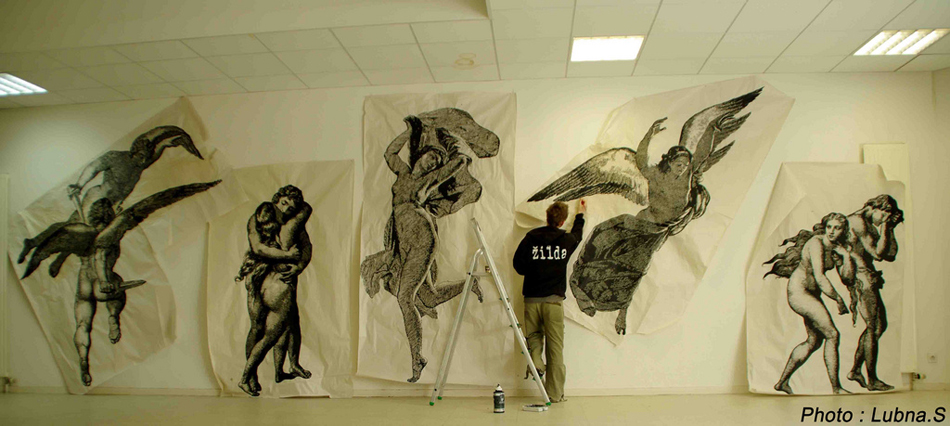
!["La mort d'Atala" #ATELIER [Žilda vs Rö]](https://blogger.googleusercontent.com/img/b/R29vZ2xl/AVvXsEg42f93mDYJ7mSHLB9_R8wtqDpsC5yXrCuSCpEbgZEjKUb9rMyEdU6rISq9RYiKKm4jvkCex-lmUAeTHFWpisVgcIbx4YoDgP78MhegLg6iTHpsDQx2tYSkDzHuJviOCkzf3Hp2OM-WVoxY/s1600/zilda+ro+peinture+atelier.jpg)
Prenošenje klasičnog slikarstva na ulice i zidove u raspadu.
http://zildaversusro.blogspot.fr/
http://zildastreetart.blogspot.fr/
http://ro.streetart.free.fr/
!["L'enlèvement de Ganymède #2" [Žilda vs Rö]](https://blogger.googleusercontent.com/img/b/R29vZ2xl/AVvXsEh-U11rl9DxUNKDhmJJaR8xSJ3KIN0w6fkpiNLTwbML7upll5Exxe5orgghSQ1jzepf1YZeJzpAC14FU8ow-5SNuKvw2SGsXEjFsj_EgzPwajUIF-Boln7ADHJkUhrPT5Ja4nRDnOfAdotU/s1600/l'enl%C3%A8vement+de+GANY+Ro+Zilda+street+art.jpg)
!["L'assassinat de Marat " [Žilda vs Rö]](https://blogger.googleusercontent.com/img/b/R29vZ2xl/AVvXsEhstcNAEcLeJztFu8l2mSPh_p6UAOuMZMS-Lwypi-ipVI_z_8R0UAGBaoHXoM8prFR9YmQjp9r5kMQHatUdhkqd_rHcLu8WBNb0L3KzDu9MbqSIEQtQVd83wr4dG6qMbhdVyPTaSkcZTowW/s1600/L'Assassinat+de+Marat+%28ZILDA+and+R%C3%96%29+street+art+Rennes.jpg)
!["L'assassinat de Marat " [Žilda vs Rö]](https://blogger.googleusercontent.com/img/b/R29vZ2xl/AVvXsEiAZULOvYbJ4tXRBujdM9VEDUsYdXB6QYbInPfMMsyL771vt0hGHOE_40kgWwxQpyP_i2h_jQNDs7JxqMZyaPhpYrgxJWiBBMCFH3ueWB1TGltUsLXy7sJWKTsewb9WRRNkurk17wxrSdw4/s1600/L'Assassinat+de+Marat+Zilda+street+art+rennes.jpg)
!["Io & Jupiter " [Žilda vs Rö]](https://blogger.googleusercontent.com/img/b/R29vZ2xl/AVvXsEhuZVLi_PP04DPVHUvIfwNBT2XX2iMNRjXwGlH1mf_105JEXdnUFWszucZIg5iLhLbt_-b47jd-nnQ9hO2turwoB_ZaUvP5f5jnw-u0GBmmlhcGA4xABvZVl-PwXxqT-nkVFfTxT6CHqvjf/s1600/io+and+jupiter+zilda+ro+street+art+paris.jpg)
!["Io & Jupiter" #PAINTING [Žilda vs Rö]](https://blogger.googleusercontent.com/img/b/R29vZ2xl/AVvXsEjWSRZP2allDMecBvNJAXOg63HQ-iJoZlWShBreofi7BAcIee5sfXkvwz0UZ64eYzTYO76qU71-Yr0YpwImbMJMlgOZPChgT9GM1YdfolfQO661zTpTnKK_sEaqLLdm37k3FJUYNWycYiJn/s1600/io+et+jupiter+peinture+zilda+ro.jpg)
![Danse Macabre [Žilda vs Rö]](https://blogger.googleusercontent.com/img/b/R29vZ2xl/AVvXsEg4qvXAcgLHl8Z5eZEDECXk8chGzidu7Uw_mVSpqd5DFkWzLFhROXOr1Bg44PvBxQWysSKs0XwlgW9aCdQVfkTOyvdHKqCdbvZ5kF3OBokfnbpwNSqoFIHtScC78TR0WOJaqhNOxASZny4K/s1600/Danse+Macabre+ZILDA+RO+street+art.jpg)
![Danse Macabre [Žilda vs Rö]](https://blogger.googleusercontent.com/img/b/R29vZ2xl/AVvXsEi5JVpOybP1G6p_KVzAik7Q0oHwGkCIjScWnkHnEhro6m8c3_CUbfCaxBtGk-ypJmiDzZqu_LPDIkcxhklG0tCLGs05gZgI_CM8p7FOLg6wg0RffPh0UU8gj7ogSiF3e3so8olxQyHaeF6Z/s1600/Danse+macabre+detail.jpg)
!["La mort d'Atala" [Žilda vs Rö]](https://blogger.googleusercontent.com/img/b/R29vZ2xl/AVvXsEj6cIfuxIx4esgRsThb1ubmyxWLJeY47pS-Vjcn0pDTDMUs00NkxriPh9lEiUMlIsedkPI4-j5m07gOrP9gSbKEsiln9K-spIVzt0d-uiq6t7YPora-U6o3EUo9mqDTEGLn4oSxKOE_LFKQ/s1600/%5BLa+mort+d%27Atala%5D+%C5%BDILDA+vs+RO.jpg)
!["Palimpseste" [Žilda vs Rö]](https://blogger.googleusercontent.com/img/b/R29vZ2xl/AVvXsEghKw8iQBEByUKvz7zK6T1kYag5YXtGlZWp79ZS5j8_EdkC_mySxZmYTTwSvnE52is0dpgiJFuTvpkk6XABlec1HdCWsA661oNQghBnqJOkQnavh18Z3_5M-klQXZX_jkBmmMhptPzyiHla/s1600/R%C3%B6+and+Zilda+palimpseste+rennes2.jpg)
!["Palimpseste" [Žilda vs Rö]](https://blogger.googleusercontent.com/img/b/R29vZ2xl/AVvXsEhfvJmkSrwC9KSps-Yu0ThKufnVVjMYtLnHenLDj-NXoCPO2KI-T97xIG9o_YQ8JBNQfJq4hizntaWvCticSA3bDxRrTyMJekJgraJT25W_mrI5NMlERfWjKVZcst6-OUAw7h7yWLftKesu/s1600/Zilda+&+Ro+palimpseste+rennes.jpg)
!["Ange terrassé par un Démon" [Žilda vs Rö]](https://blogger.googleusercontent.com/img/b/R29vZ2xl/AVvXsEiEJyxApVVYfxseU7HrQFg4JifBqd_EF_U-AuAGi_qD6oadHN3fBElq9t7fdGq-K4COaysyddm49VDyjGQT6eej500RX6MO1gEPxvcP6a2Gzp_x_-3fiCDwgVwfykv_NRL9eplSpDfECY9c/s1600/ange+et+demon+zilda+ro+street+art+Painting.jpg)
!["Rimbaud" [Žilda vs Rö]](https://blogger.googleusercontent.com/img/b/R29vZ2xl/AVvXsEhM6NXo4mXP05KgIDuRnk6Le3sF4GXAvQxOGozSQX_iaSLQdGblWH8wXXvOVheL583pwISpOYD5X3E4Dv3wRgnOawRy90pw_VhXOpeHcpIZGNb9nZ6wqhfVMo2rlgvL9uAUfCITRCmmbbCo/s1600/rimbaudmania+Zilda+Ro+expo.jpg)
Žilda:



































Sometimes you see art so stunning being created that it doesn’t leave you with much to else to say. That’s what happened after I watched a video of a colllaboration of French street artists Žilda and Rö reinterpreting L’assassinat de Marat (The Assassination of Marat), a painting by Jean-Joseph Weerts. I immediately contacted the two and they were kind enough to agree to our quickie interview.
Could we get you to comment on that piece?
Žilda : This is a two-person work entirely made with paper brush. The point of this pictorial collaboration was to have our worlds and styles (which are quite different) meet on behalf of one and the same setting up.
Rö : It took almost one year before this project came into existence. We had to do a lot of spotting before we found the ideal location, offering the same architectural layout as the original work.
Žilda : ..the place also had to recreate the atmosphere of the painting.. it was essential to choose a “setting” respecting its private atmosphere, slightly theatrical, and offering quite precise lighting conditions.
We’d love a blow by blow of that day and how you decided on that piece.
Žilda : One day, we were at the” Crime & Punishment” exhibition in Paris, where that famous painting of Jean-Joseph Weerts’ was being displayed. It was a real blow! A revelation for the two of us..
Rö : We thought it would be very exciting to take over that work by adapting it our way and adding our own staging…
Any signifigance?
Žilda : It’s a little like our “Ode to Charlotte Corday“. But of course under a visual and artistic pretext..
Rö : …and for the fun of it! We were keen on handing this rather tragic theme with a tongue-in-cheek approach, by being absolutely ourselves.
Žilda : It’s not just about adaptation or pictorial interpretation. It’s first and foremost setting up. According to the place, the furniture, the light…
Rö : Yes..we work with visual, concrete materials, which can be “shaped”…that is the exact opposite of the canvas.
What’s the mission statement?
Rö : The place of our “Marat’s murder” wasn’t accessible to the public and the actual spot was destroyed a few days after the setting up… so we wanted to share our little fleeting lunacy through a video.
Žilda : By the way, we need to thank the author of that video who made it with great involvement and inventivity. Thank you, Colin ! - hahamag.com/
ART HISTORY – ZILDA / C215
- BY
You can’t deny that iconizing is a huge part of ‘modern’ street art. I don’t know if it’s the legacy of Andy Warhol or that it’s just the easy thing to do, but stencilling, illustrating, spray-painting and altering icons or iconic sights, symbols, photographs seems to make-up a big part of what we call street art. That is not necessarily a bad thing though, it might be a good mirror of our current civilization; Worshipping God(s) made place for idolising and iconizing celebrities and known figures. But what is hard to grasp, is that 90% of the artists get their inspiration from the pop-culture out of the last century. This makes for a whole lot of MJ’s and Marilyn Manroe’s traced in Illustrator. I know it’s a gross exaggeration but you catch my drift!
Enter C215 and Zilda. I don’t think I need to introduce these artists, but if you don’t know them, please take the time to look at their Flickr accounts. Even though these artists are both from France, they are totally different. One mainly works with stencils, the other mainly with paste-ups. One mainly works on the crowded streets, the other searches his favorite spots in derelict buildings. Still, every once in a while, they both get their inspiration from the same place in history: the Renaissance. Looking at some of their works based on the old masters (the common master between the two being Caravaggio) I was inspired to ask them a couple of questions: What makes their work so unique? How does their art-history knowledge influence their work? Is too much street art just a mere imitation, and if so, why?
C215: the philosopher Heraclitus said: “No man ever steps in the same river twice” and it means that every life, every period is unique and cannot be compared to anything else. Modern classics are discussing with classic from the past, and the era that began after Duchamp, completely conceptual, is now over to take place in reality in our 3D world and especially the streets. For me quoting Caravaggio is a good way to speak about my influences, my own history and feeling. The Narcissus one process has been a deep psychological trip … my graffiti is always self-expression, supported by my street experience and my culture. I think that we are, after the Duchamp’s “Art is dead”, living a new Renaissance. Good to believe in Humanism again.
Sure that the young artists, as well as the general public sometimes miss a good knowledge of art history to escape being naive. Most of the times we’re confused between fashion, trends art history. And art history is highly selective..
Zilda: I don’t think my work is as unique as you say, certainly not when it comes to style. When I look into a painter’s work, I rather tend to give way to his style.
To me, replicating a work is not only interpreting it pictorially. The most important is what you do with that painting. I like picturing it, contextualizing it in the urban space and photographing it with regards to its surroundings. Sometimes I set up some kind of staging, shit like that.
I’d rather talk about emotions aroused by some works. I like feeling like shit in front of a painting, looking at it as an equation you need to solve.
I don’t like putting my ass on a chair and coldly analysing a work. I’d rather address it frontally, physically and get close to it. Ingesting it, drawing it, painting it, interpreting it is a way of going all the way through my obsession.
I think you’re a bit harsh. Street art can’t be summarized to that. There are so many artists with fucking personalities and worlds of their own. On the contrary, it’s nice to see individuals making their way while keeping a bit of ethics and showing us that street art is not only about fashionista, galleries, money, the race for prestige, buzz and all that shit. - cfye.com/
Interview: Zilda
Posted by sleepboy,
French artist Zilda’s classically influenced street work are inspired by old books and works of the master painters and sculptors of the past. With such a wealth of material to refer to, it was somewhat surprising to find out that his work is all originally hand-painted. We talked about his history, technique, and future, among other things in our interview – all after the jump.
Arrested Motion (AM): Can you tell us a little about yourself (where you are from, your background, whether you have any formal art training)?
Zilda: I come from Rennes (West of France) and I’m self-educated. I quit school early to travel all over Europe. I made a living by selling pictures I painted on my way. So far, my life has been a bit rough around the edges… Before engaging in painting, I was alternately a punk, a beggar, depressive, an activist and a librarian.
AM: What inspired you to create your recent series, taking your version of classical sculpture and paintings to the streets?
Zilda: That’s a passion for old books and popular press which brought me into contact with a whole set works (engravings, prints, sketches…) that are forgotten or little known from the public. I can’t stand the idea that those pictures are exclusively owned by collectors, bourgeois libraries or museum archives.
My work is based on a mythological, literary and pictorial iconographic corpus and pays tribute to many illustrators that history unfairly forgot. In some ways, I want founding myths to interact with our puritanical contemporariness [sic].
AM: There is a certainly a rich history of French street artists – Blek Le Rat, Miss Van, Jef Aerosol, JR – to name a few. Are there any that you admire or are influenced by their work?
Zilda: I’ve got only one inspiration as far as street art is concerned. And that is Ernest Pignon Ernest. I like the radicality of his work, the strength of the themes he deals with and so, the great respect he has for the public.
He is a man who brought important issues in public view …
AM: Can you tell us a little about your technique? Do you draw all your own work?
Zilda: I think it’s very important to paste up only original paintings (made on paper) in the street. People seem to be concerned about the fact that this amount of work is doomed to deletion. I would say that what I do in workshop is like “pictorial cooking”. It’s some kind of grub that tests the effects of calligraphic nib, posca, eye liner, cotton buds…
AM: Any shows or projects for the rest of 2010 that you can share with us?
Zilda: I’m going to carry on the « unproductive expenditure », devoting my time to creating for the transient… I intend to revive and stage some founding myths found in the “Ovide’s Metamorphoses” on the walls of different cities. - arrestedmotion.com/
Interview with Zilda
By dumbwall
I’m working on a project called “Fragiles Fabulae”. The point is to revisit “classical” pictorial works by putting them into context in the street. Lately in Naples, I had a great time making appear symbolist and pre-Raphaelite-inspired paintings in waste lands, garbage dumps…
Hundreds of artists out there make pieces every day. How do you think could be your style defined?
My work style is not essentially defined by the graphic characteristics of my paintings. I think that being a street artist is before all being a plasticien, open to a full range of practices. What triggers me is being able to develop a style in a more general way, in a personal way of fitting a painting in the street, working on a precise theme depending on a precise place, or thinking about a photographic approach, a mise en scène….
Painting, engraving, comics, plasticienne photography, Land art, silent films, bar chats, the ass of a girl passing by.
A lot of artists want to be published on art blogs. It seems that in these days a painted wall does not exists without re-blogging. What’s your Pov?
Yes indeed. Internet enables to extend the life length of works doomed to disappear but also to make them visible beyond street space. So that’s quite an interesting window display for artists. However, I think it’s bullshit to believe that a work can only exist if it is seen by as many as possible. If an artist creates, it must primarily be for him.
Someone said: “a wall is a very big weapon”. Do you find the same nowadays, while we’re surrounded by millions of billboards? I mean, don’t you find even thinner the line between art and ads?
That’s sad but that’s the reality… Clearly, more and more street artists use the same codes, the same propaganda will as advertising. An artist’s name becomes a brand as soon as he chooses to spread excessively his production or his slogan like shit on the walls… inevitably, his signature impresses itself in a lot of people’s minds. A wall can also be used to make the masses numb.
Make a passer-by stop and start a dialogue with a work. Or just tell him a story for a few seconds.
I mean, do you feel connected with the so called “street art movement”?
I’m not interested in the street art movement. There are many talented artists with very peculiar graphic universes but only few of them talk about emotion.
I’m not really interested in Art exchange.
What role do you find galleries can play in helping an artist to emerge from the streets?
I think that for almost all street artists, exhibiting their works in a gallery is a step towards recognition, some kind of stupid ass confirmation. As far as I’m concerned, I’ve always said that my work takes its full meaning in the street, so, exhibiting it in a gallery would discredit my approach. I don’t need to exhibit my work in a gallery for it to exist. And I certainly don’t want anybody to speculate on my work.
I’m more inclined to look forward. I think the best is always ahead of us..
Of all the projects you’ve done, which has been most satisfying?
Working in Naples was by far my nicest experience . Both artistic and human.
I will pursue my project “Fragiles Fabulae” in another European city. This time, I leave Italy to confront my paintings to other «settings», to a more Nordic atmosphere. I think I will work for some time in a city like Hamburg.
+
Rö
!["L'enlèvement de Ganymède #1" [Žilda vs Rö]](https://blogger.googleusercontent.com/img/b/R29vZ2xl/AVvXsEgFTu4aDrjbNF3NTkmXETqnATUcgT_4oUAXq0WAJ4-3gNeB6OFoN6LtBQ_hv4DsBT69ptwdMofqUMH9VL5OJF97HluwMB68f3udAEPcMd7wxh0YdXMPwZ3JpgxcSxRBcvGdbWg63t_mEROy/s1600/gany.jpg)
!["Un combat Eclair" [Žilda vs Rö]](https://blogger.googleusercontent.com/img/b/R29vZ2xl/AVvXsEjHeO0qaEtJ2PX3-_mgyPfLtPlbusRSaZIapR0OeP5y977zPnlxYATgTQdyBF9hvjLjavgJuk8EN-0XqQbpNZIgJuLKJC4aDfNABB5s8JIDf9F6FxErrpE2RHK8pUt9zc9KZ3x0J2iai7Yk/s1600/zilda+ro+street+art+barcelone.jpg)
Nema komentara:
Objavi komentar